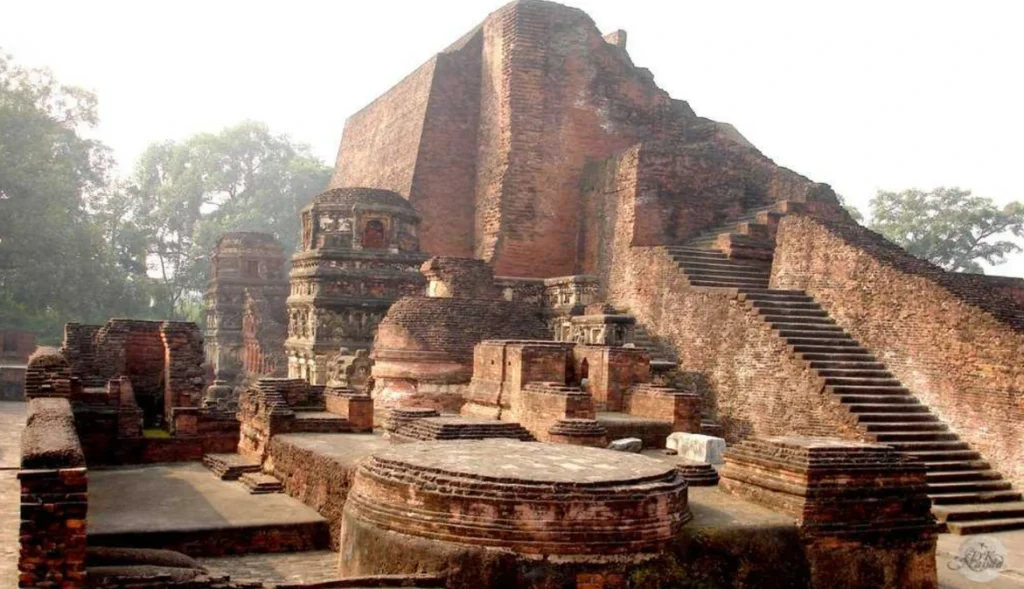“Explore Nalanda District, Bihar—home to ancient wisdom, rich heritage, and progress. Discover its history, culture, and remarkable legacy.”

Nalanda District: Power, Legacy & Timeless Glory
Nalanda District, situated in the eastern Indian state of Bihar, is a land steeped in history, knowledge, and cultural heritage. It is renowned for being home to the ancient Nalanda University, a center of learning that attracted scholars from across the world. Here, amidst the tranquil countryside, the echoes of wisdom from centuries past still resonate.
Nalanda’s historical significance is primarily attributed to the Nalanda University, which dates back to the 5th century CE. This revered institution was a melting pot of knowledge, philosophy, and spirituality. Scholars like Aryabhata, Nagarjuna, and Hieun Tsang graced its hallowed halls, contributing to the advancement of various disciplines, including mathematics, astronomy, and Buddhism. Today, the ruins of Nalanda University are a UNESCO World Heritage Site, attracting history enthusiasts and academics from around the globe.
Beyond its academic legacy, Nalanda District offers a glimpse into India’s rich cultural tapestry. The town of Rajgir, located within the district, is famous for its association with Lord Buddha. It was here that Buddha delivered many of his sermons and meditated atop the Griddhakuta Hill, also known as the Vulture’s Peak. Pilgrims and spiritual seekers flock to Rajgir to visit these sacred sites, making it an essential stop for those interested in Buddhism.
Another significant historical site in Nalanda is the ancient Nalanda Archaeological Museum. This museum houses a vast collection of artifacts, sculptures, and manuscripts that provide insights into the district’s rich heritage. It’s a place where history comes to life, allowing visitors to connect with the past.
Nalanda District is also known for its serene natural beauty. The picturesque Pawapuri Lake is a tranquil spot where Lord Mahavira, the founder of Jainism, is believed to have attained Nirvana. The surrounding temples and the shimmering lake create an atmosphere of tranquility and spirituality.
In addition to its historical and cultural attractions, Nalanda is an agricultural hub, with fertile land that supports the cultivation of various crops, including rice, wheat, and sugarcane. The district’s agricultural activities contribute significantly to the state’s economy.
Over the years, Nalanda has seen developments in infrastructure and education. The presence of educational institutions, including colleges and schools, ensures that the youth have access to quality education. Improved transportation networks have made the district more accessible to tourists and residents alike.
Famous Places in Nalanda District
Nalandaa District in Bihar, India, is a land steeped in history and culture, with numerous famous places that reflect its rich heritage. Here are some of the most prominent attractions in this historically significant region:
Nalanda University Ruins: Explore the UNESCO World Heritage Site of Nalanda University, where ancient scholars once gathered to pursue knowledge. The ruins include impressive stupas, monasteries, and remains of an ancient library.
Rajgir: Visit this ancient town nestled in the hills, where Lord Buddha delivered many of his teachings. The Griddhakuta Hill (Vulture’s Peak), the Japanese Peace Pagoda, and the hot springs are among the notable attractions in Rajgir.
Pawapuri: This serene town is famous for the Jalmandir, a temple built in the middle of a lake, where Lord Mahavira, the founder of Jainism, is believed to have attained Nirvana. It’s a sacred pilgrimage site for Jains.
Nalanda Archaeological Museum: Immerse yourself in the history of the region at this museum, which houses a remarkable collection of sculptures, artifacts, and manuscripts excavated from the Nalanda University site.
Hieun Tsang Memorial Hall: Dedicated to the famous Chinese traveler and scholar, Xuanzang (Hieun Tsang), this memorial hall showcases his life, travels, and contributions to Buddhist studies. It’s a place of historical significance.
Hiuen Tsang’s Monastery: Visit the ruins of the monastery where Xuanzang is said to have studied during his time at Nalanda. The site offers a glimpse into the ancient architecture and monastic life.
Veerayatan Museum: Located in Pawapuri, this museum exhibits an impressive collection of artifacts related to Jainism, including sculptures, manuscripts, and historical relics.
Son Bhandar Caves: These ancient caves are believed to date back to the Mauryan period and are known for their intricate rock-cut architecture and inscriptions.
Gridhakuta Peak: Trek to the top of this hill to reach the Vulture’s Peak, where Lord Buddha is said to have delivered important sermons. The panoramic views of the surrounding landscape are breathtaking.
Kundalpur: This small village is significant for its Jain temples, particularly the Digambar Jain temple dedicated to Lord Mahavira. It’s a peaceful place for reflection and spirituality.
Nalanda: The modern town of Nalanda is a gateway to the historical sites in the district. It offers accommodation, dining, and easy access to the nearby attractions.
Nalandaa District’s famous places offer a unique opportunity to delve into India’s ancient wisdom, spirituality, and history. Whether you’re a history enthusiast, a spiritual seeker, or a curious traveler, this district provides a captivating journey into the past and an appreciation of its cultural significance.
Read More :-
